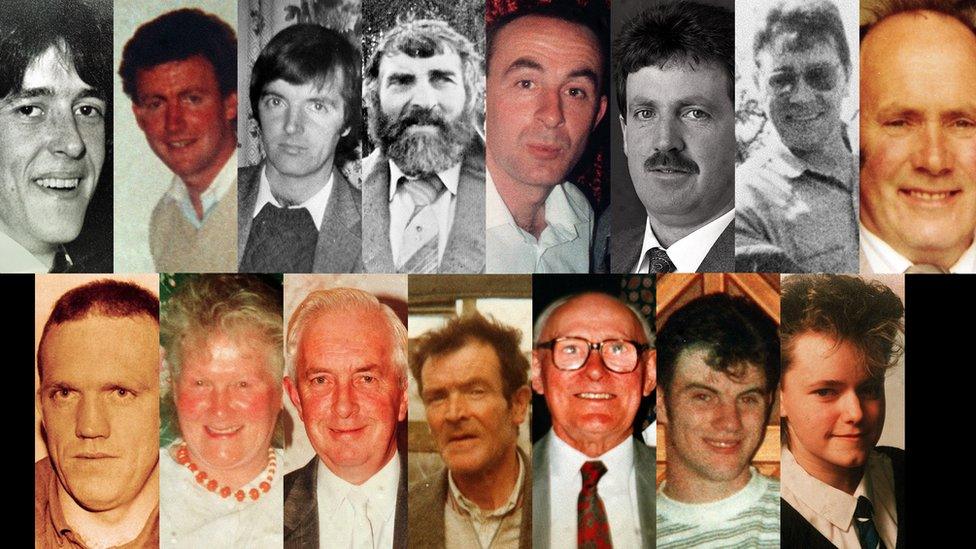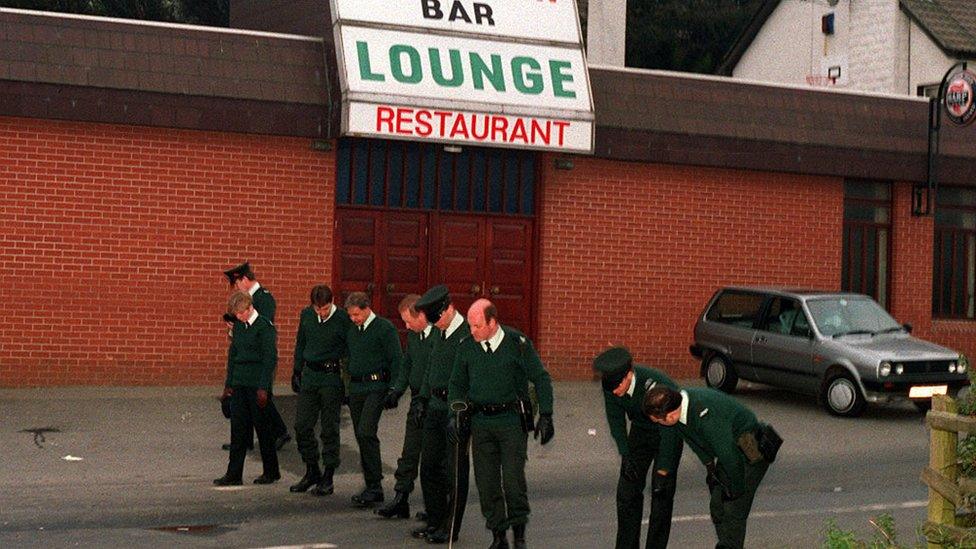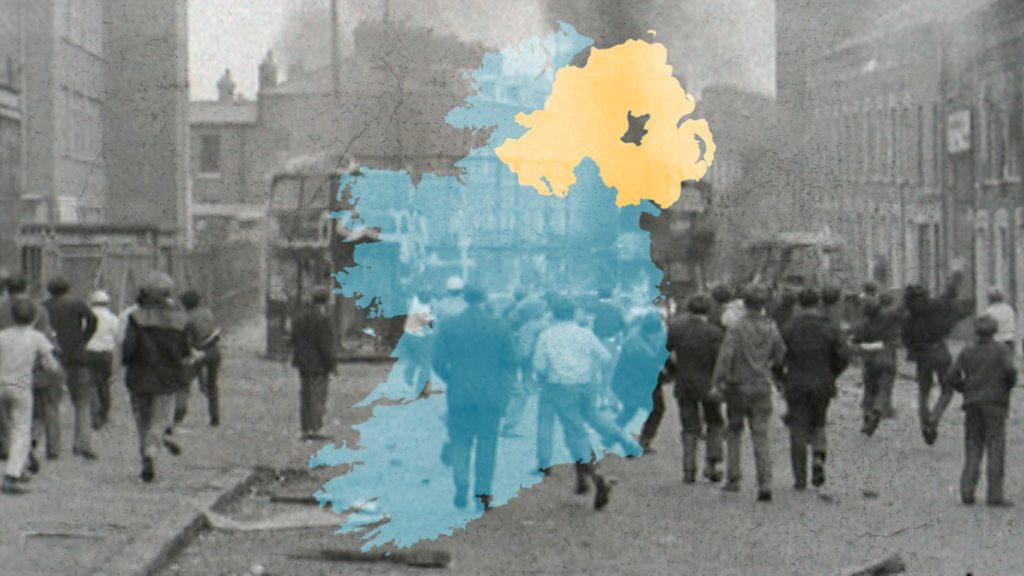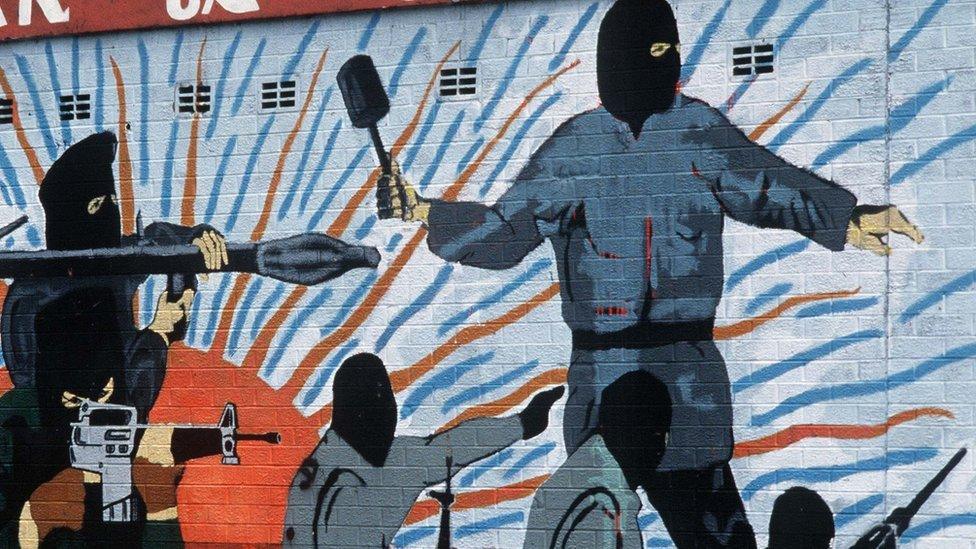Troubles: Police 'failed to warn murder victims about threats'
- Published

The ombudsman looked into the murders of 19 people, including some not photographed
Police failed to warn several murder victims - including two Sinn Féin councillors - that they were under threat, a report on Ulster Defence Association (UDA) attacks has stated.
The police ombudsman looked into 19 murders, including the Greysteel massacre, and its report uncovered no evidence police had prior knowledge of any of the shootings.
But it found "collusive behaviours".
This included indications members of security forces passed on information.
Other examples cited were intelligence and surveillance failings leading to the arming of loyalists and the deliberate destruction of records relating to informants.
The ombudsman also expressed "significant concerns about police conduct".
The Police Service of Northern Ireland (PSNI) said policing was much changed in the present day and that it remained committed to bringing the killers to justice.
Deputy Chief Constable Mark Hamilton said the PSNI was aware of the hurt and anger felt by the families of those killed and those injured and apologised to them for the findings in the report.
The 336-page report covers 11 sectarian attacks carried out by a faction of the loyalist paramilitary UDA in the north west between 1989 and 1993 and claimed using the cover name of the Ulster Freedom Fighters (UFF).
Some of the victims were killed in random attacks, but others were individually targeted as members of Sinn Féin or the IRA.
Among the victims were Sinn Féin councillors Eddie Fullerton and Bernard O'Hagan.

The full list of incidents examined:
The murder of Gerard Casey at Rasharkin in April 1989.
The murder of Eddie Fullerton at Buncrana in May 1991.
The murder of Patrick Shanaghan at Castlederg in August 1991.
The murder of Thomas Donaghy at Kilrea in August 1991.
The murder of Bernard O'Hagan at Magherafelt in September 1991.
The attempted murder of James McCorriston at Coleraine in February 1992.
The murder of Daniel Cassidy at Kilrea in April 1992.
The attempted murder of Patrick McErlain at Dunloy in August 1992.
The murder of Malachy Carey at Ballymoney in December 1992.
The murders of Robert Dalrymple, James Kelly, James McKenna and Noel O'Kane at Castlerock in March 1993.
The murders of John Burns, Moira Duddy, Joseph McDermott, James Moore, John Moyne, Steven Mullan, Karen Thompson and Samuel Montgomery at Greysteel in October 1993.

The report has taken years to compile, following an initial complaint made by Mr Fullerton's family in 2006.
The report stated that the 56 year old was one of six people murdered whose names had been found in caches of loyalist intelligence information recovered by police.
Most were not informed they were under threat - a contravention of procedures.
The report was unable to conclude if notification "in itself" would have been sufficient to protect people.

The report was compiled by Marie Anderson
However, a threat notification "would have allowed them to review their personal safety measures".
Ombudsman Marie Anderson said that in 1989 the police were aware of the "growing threat" posed by the north west UDA.
She went on: "This increased threat was not initially accompanied by a policing response proportionate to the increased risk to members of the republican and nationalist communities."
Ms Anderson told BBC News NI that she had "identified a number of collusive behaviours on the part of the Royal Ulster Constabulary (RUC) and its officers".
She said the failure to warn Mr Fullerton and others about attacks was not in keeping with RUC force orders.
"Was it deliberate? The absence of records makes it difficult to conclude," she said.
Some of the information about the threats that came to the police originated from security forces.
"There were a number of paramilitary intelligence caches during 1989 to 1993 and some of it was personal information relating to the individuals who were then attacked. Some of it was of military origin," she said.
Mr Fullerton was not warned but a couple of other Sinn Féin councillors in Derry were warned, she said.
"I can't find any rational as to why some were warned and some were not warned," she said.
Mr Fullerton's daughter Amanda Fullerton, who was 27 when her father was murdered, said she had mixed emotions about the findings.
"I feel sad but I welcome the report as the ombudsman has vindicated our position all along," she said.
She said her father had received a death threat long before he had been murdered.
"My father was well aware of the threat at the time anyway as this was a period of serious unease, assassinations by the UDA and it was well known that the members of the security forces were colluding with the UDA," she said.
"So I am not sure that my father could have prevented it.
"When you have security forces colluding with loyalist paramilitaries there's very little you can do to avoid the outcome - they are intent on murder and that's what happened."

What is the UDA?
The Ulster Defence Association, formed in 1971, had tens of thousands of members at its peak.
It killed hundreds of people during the Troubles in Northern Ireland and often claimed responsibility for sectarian murders using the cover name the Ulster Freedom Fighters (UFF).
A security assessment in 1985 found that 85% of the intelligence used by the UDA to target people originated from the police and army and it was heavily reliant on leaks of information.
The UDA remained a legal organisation until it was banned in August 1992.
Notorious attacks by the UFF included the shooting dead of five Catholics at a Belfast bookmakers in 1992 and the Greysteel massacre the following year.
In November 2007, the UDA issued a statement saying: "The war is over".
It later said it had stood down the UFF and all UFF weapons were being put "beyond use", but that did not mean they would be decommissioned.
In 2018, the then PSNI Chief Constable George Hamilton said members of the UDA were still involved in organised crime.

Her report also stated there were links between the UDA and members of the police and the Army's Ulster Defence Regiment (UDR).
But police failed to deal "appropriately" with members of the security forces suspected of, or involved in, the passing of sensitive information.
One of two former police officers she reported to the Public Prosecution Service (PPS) during the course of her investigation was suspected of leaking information.
The other had failed to disclose a suspect in one of the shootings was also an informant.
The PPS directed that neither individual should be prosecuted.
Mark Thompson, of Relatives for Justice, speaking on behalf of a number of the victims' families, said they had been "vindicated in their long-held belief that collusion was a dominant theme in the murders".
Ms Anderson's report stated that "generally" police investigations into the attacks were prompt and thorough, resulting in a number of convictions.
It also found a number of instances where they obtained information from informants which disrupted the UDA and "may have saved lives".
The worst of the attacks was at The Rising Sun bar in the village of Greysteel in County Londonderry in October 1993, which left eight people dead - seven Catholics and one Protestant.

The killings in Greysteel happened a week after the Shankill bombing as people were celebrating Halloween
One of the gunmen shouted "trick or treat" before he opened fire.
It was in retaliation for the IRA's Shankill bombing a week earlier.
The report stated that while it was predicted UDA activity would escalate in response to the bombing, there "was no specific intelligence that the North West UDA was planning an attack".
PSNI Deputy Chief Constable Mark Hamilton said: "The peace process has changed the context for policing.
"The Police Service of Northern Ireland now have greatly improved policies and procedures which guide our response to potential threats and how we approach criminal investigations and the management of intelligence.
"These policies and procedures are firmly embedded in principles of the Human Rights Acts 1998. We welcome the fact that the ombudsman has recognised these positive developments in her report.
"The Police Service of Northern Ireland remains firmly committed to bringing those responsible for these murders to justice.
"We appeal to the community for information that will assist our Legacy Investigation Branch detectives in their investigations.
Solicitor Niall Murphy, whose firm represents some of the families involved, said: "Regretfully, it is of no surprise and confirms and validates complaints and concerns the families have had for decades.
"This report should not be read in a vacuum but should be read in a sequence of public statements that confirm the policy of collusion was a systemic state policy," he told the BBC's Good Morning Ulster.
He added that the report was a "significant body of evidence" that he would reflect intently on and consult with his clients as to what was the next step.
"I suspect in the fullness of time there may be a coherent call for a public inquiry into how our society was policed in the late 80s and early 90s," he said.
'Blatant disregard for life'
The UFF claimed responsibility for the 1991 gun attack which killed Patrick Shanaghan in Castlederg, County Tyrone.
His family have welcomed some aspects of the ombudsman's report which said that their concerns about collusion in regards to his death were "legitimate and justified".
The report touched on the fact that a police officer had prevented a local doctor from giving Mr Shanaghan medical treatment at the scene of the shooting.
However, the family was also critical that the ombudsman was not able to deal with their claims that in the lead up to his killing, Mr Shanaghan had been subjected to harassment and death threats from police officers.
In a statement, the family said, "What is most distressing for us was the blatant disregard the police had for Patrick's life and the inexcusable refusal of police to allow medical assistance for Patrick after he was shot.
"As in life, Patrick was in death, denied the most basic of human rights."
Related topics
- Published13 August 2019

- Published2 December 2020
